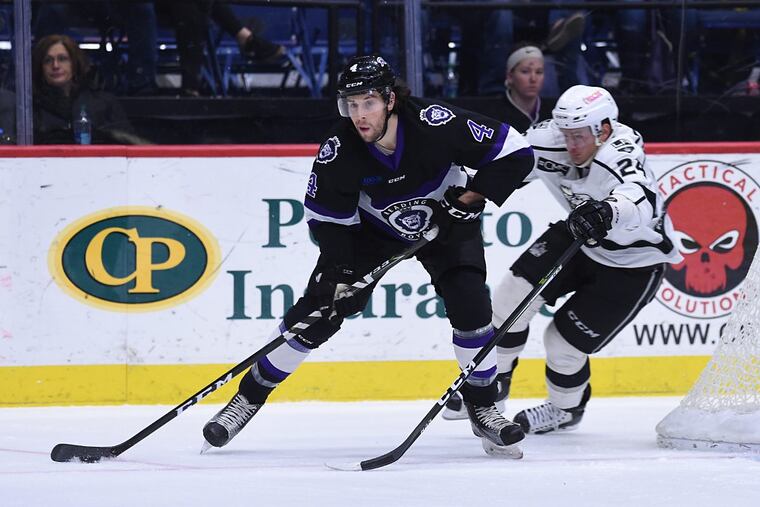Long bus rides and long odds: The ECHL dream
There have been 599 players make it to the NHL from the ECHL, but 407 since the league was reorganized just 15 years ago.

First of two parts. (Here's Part 2.)
The lifestyle is addictive, said Nolan Zajac. The games, the travel, the camaraderie of a team on a mission, even if that mission takes you from Toledo to Tulsa in pursuit of something fleeting, even as you add another year to the pursuit of a dream you have clung to since you were a kid.
That's what keeps you going mostly in the ECHL. That, and this: "More and more, it seems you hear these guys in the NHL telling their stories about playing in the East Coast," said Zajac, who signed to play with the AHL Lehigh Valley Phantoms over the summer after starring for the ECHL Toledo Walleye last season. "Either they were undrafted or people weren't quite sure about them, and they made the most of their opportunities.
"I hear about those stories and I think, why not me? Why can't I be that guy?"
When camps broke last October, there were 76 former ECHL players on NHL rosters. That pushed the total number of NHL players who have made the unlikely graduation from a league once known for fighting and under-financing to 599 total, and to 407 since 2002-03.
That was the season when the league reorganized, renamed itself simply "ECHL," and sought a more legitimate role as an additional developmental league for the AHL and NHL. Bolstered by an influx of young European players seeking to become accustomed to the physicality and smaller rinks of the North American game, as well as undrafted players from both the long-established college teams such as Zajac's University of Denver team and the hundreds of more recent Division I programs, the ECHL has become a haven of hope over the last two decades.
Manny Legace, Tim Thomas, Jonathan Quick, and former Flyers Ruslan Fedotenko and Dan Carcillo are some notable alums. The most recent poster child of hope, however, is Nashville's Frederick Gaudreau. After Nashville suffered injuries to two centers during last season's run to the Stanley Cup finals, Gaudreau — who had played in the ECHL just a season before — filled in and scored the winning goal in Games 3 and 4 against Pittsburgh.
In 11 previous seasons before this one, 343 players who once wore an ECHL jersey have donned an NHL sweater. That's a huge jump from the 97 who made that unlikely climb in its first 10 seasons after the 2002 reorganization. It's also a big reason that more than 20 NHL clubs, including the Flyers, have invested money through affiliations with ECHL — and a big reason players such as Zajac are still lacing them up.
Nolan, 25, is the youngest of four hockey-playing brothers, the most notable being injured New Jersey Devils star Travis Zajac, who was taken 20th overall in the 2004 draft. Darcy, 31, is out of hockey but Kelly, four years Nolan's senior, is still mucking and grinding for the South Carolina Stingrays, a Washington Capitals affiliate.
A forward when he arrived at the University of Denver, Nolan Zajac blossomed into a puck-carrying offensive-minded defenseman who finished his career among the school's all-time top scoring defensemen. Playing last season for the ECHL Toledo Walleye, he scored 11 goals and had 43 assists, fourth best among the league's defensemen. He made the ECHL all-star team as well.
That got him loaned to three AHL teams. Got him traded too, first to Wichita, and over the summer to the Reading Royals, the Flyers' ECHL affiliate. You may have heard — several Phantoms defensemen are targeted for Philadelphia this fall. That pokes open positions in Lehigh Valley, which is why Zajac signed an AHL contract one day after Reading acquired him, and why the Flyers re-signed 25-year-old Maxim Lamarche to another AHL contract.
A rising star in his youth, Lamarche struggled in juniors and went undrafted. But he is righthanded and big — 6-foot-3, 220 pounds — and when the Flyers signed him to his original three-year entry-level deal, they were not exactly teeming with defensive prospects.
"He's gotten better every year," Flyers president Paul Holmgren said. "And more confident. He could be one of those guys who fill a role for us or somebody else someday."
Said Lamarche, "I try not to make a timetable. Just work hard every year, learn every year, try to get better every year. See where it will take me."
It's the only mentality to have, really, when you start your professional career in a league that pays $400 to $525 a week to most players. Where the long bus rides serve only to remind of the long odds of ever realizing your dream.
"It's definitely a young man's game, but I think I'm still at a good age," said Zajac. "I've developed more skills. And there's more maturity to my game on the ice. Playing in certain situations and reading the ice and developing that a little more. Offensive defenseman. Stay at home. I like to pride myself on playing both ways.
"Give me any role and I'll play it."